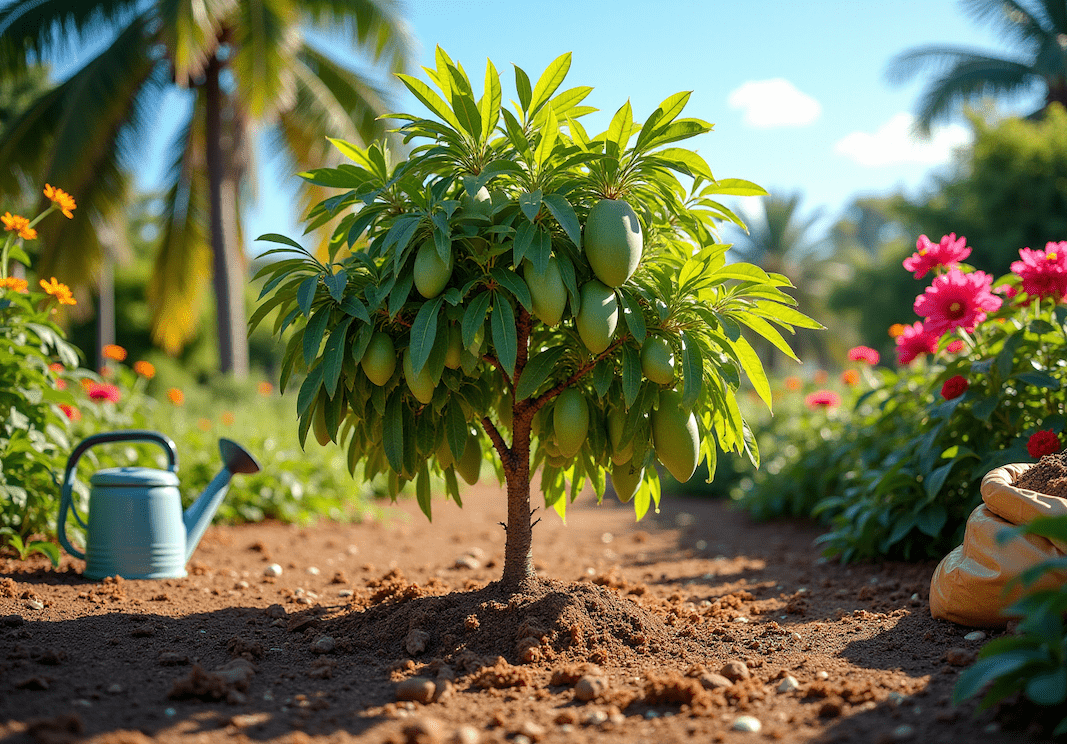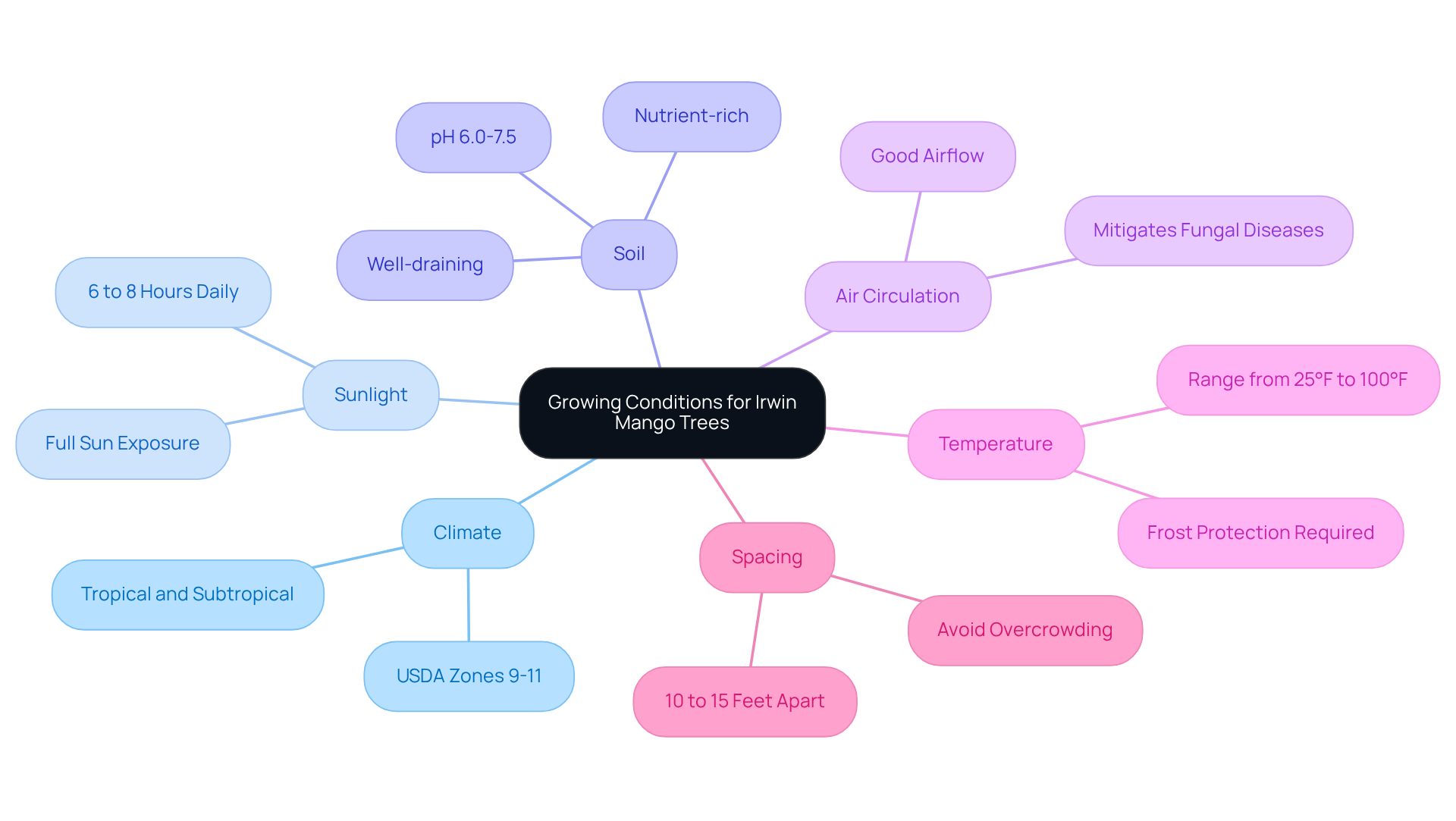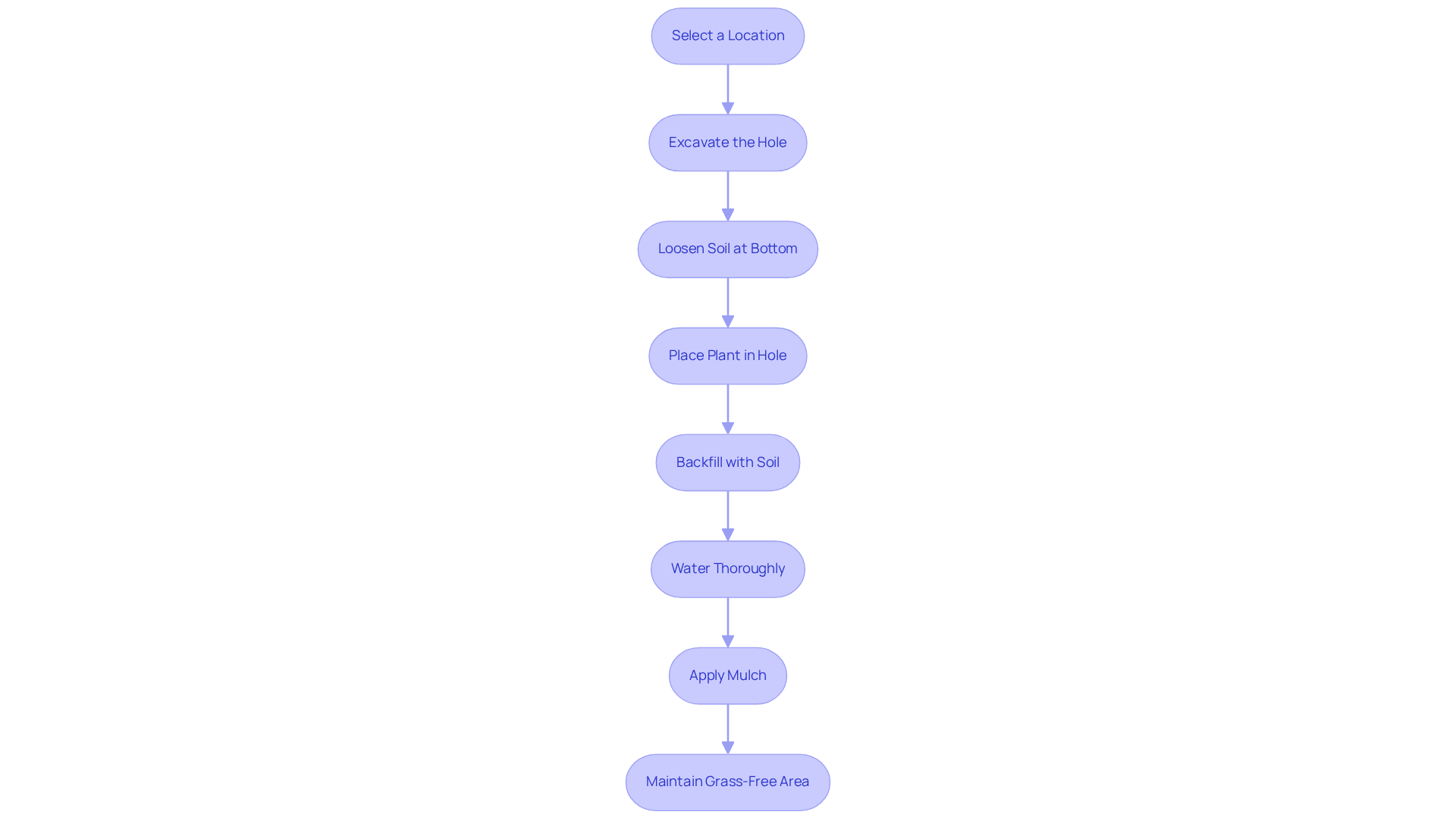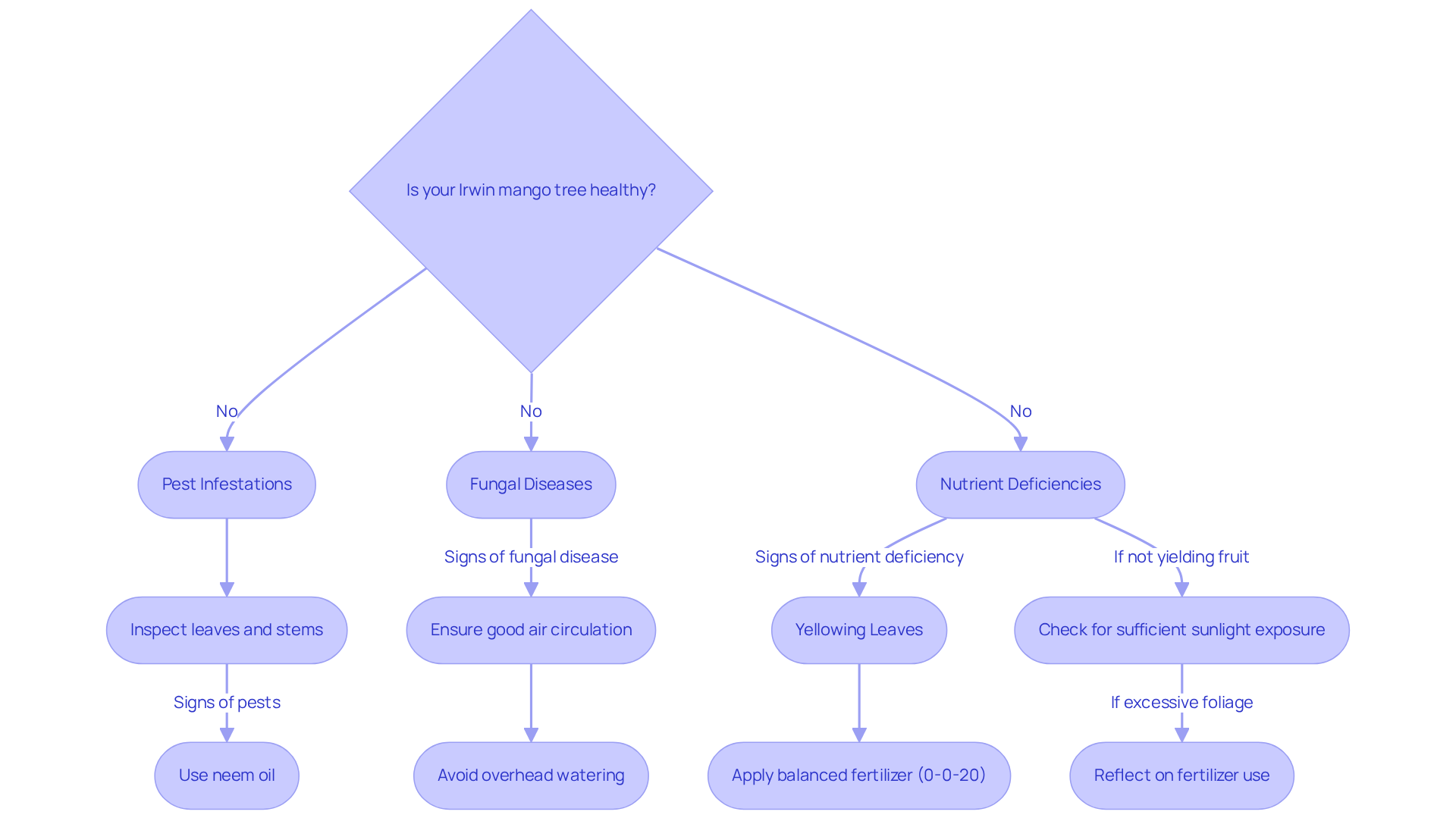
4 Steps to Successfully Grow Your Irwin Mango Tree
Share
Cultivating an Irwin mango tree can be a rewarding endeavor, offering not only lush greenery but also delicious fruit. This guide delves into the essential steps for successfully growing these tropical treasures, highlighting their specific growing conditions, proper planting techniques, and ongoing care.
However, even the most dedicated gardeners may encounter challenges along the way. What are the common pitfalls that could hinder the growth of these vibrant trees?
Exploring the nuances of Irwin mango cultivation reveals both the joys and complexities of nurturing these beloved plants.
🥭 Thinking about growing a Mango Tree in your garden?
Explore Irwin Mango Tree for sale at Everglades Farm - shipped directly from Florida.
1. Understand the Growing Conditions for Irwin Mango Trees
Irwin mango trees thrive in tropical and subtropical climates, making them suitable for USDA zones 9-11. These plants require , needing a minimum of 6 to 8 hours of direct sunlight each day to ensure vigorous growth and fruit production. The optimal soil for the Irwin mango tree is well-draining, nutrient-rich, and slightly acidic to neutral, with a pH level ranging from 6.0 to 7.5. Incorporating organic compost significantly enhances soil fertility and drainage, promoting healthy root development.
Additionally, selecting a planting site with good air circulation is crucial to mitigate the risk of fungal diseases, particularly in humid environments. Consistent temperature observation is essential, as certain varieties can endure a range from 25°F to 100°F but must be protected from frost to guarantee optimal growth. Moreover, spacing these plants 10 to 15 feet apart is vital for sufficient air circulation and to avoid overcrowding.
For those looking to enhance their tropical gardening journey, explore Everglades Farm's Fast-Growing Trees selection for the perfect variety of mango, along with high-quality fertilizers that support healthy growth.

2. Plant the Irwin Mango Tree Properly
To successfully plant your Irwin mango tree, begin by selecting a location that receives full sunlight and offers good drainage, ideally in light sand or limestone. Excavate a hole that is three times the diameter and twice as deep as the root ball of the plant, providing ample space for root expansion. Loosening the soil at the bottom of the hole is essential, as it promotes healthy root development crucial for the plant's establishment. When placing the plant in the hole, ensure that the top of the root ball is level with the surrounding ground to around the trunk.
Backfill the hole with the original soil, gently tamping it down to eliminate any air pockets that could impede root development. After planting, water the plant thoroughly to help settle the soil around the roots. As gardening expert Michael Pollan notes, "The garden suggests there might be a place where we can meet nature halfway," underscoring the importance of nurturing your plants from the outset. Additionally, Russell Page emphasizes, "If you wish to make anything grow, you must understand it, and understand it in a very real sense."
To further support your plant, apply a layer of mulch around the base; this will aid in moisture retention and weed suppression, creating an optimal environment for your variety to flourish. Remember to maintain a grass-free area around the trunk to prevent injury and competition for nutrients. Choosing a healthy nursery plant like the Irwin mango tree is also vital for successful planting, ensuring that your fruit-bearing plant has the best possible start.

3. Maintain and Care for Your Irwin Mango Tree
Caring for your specific mango variety requires dedication to adequate irrigation and nourishment, particularly during its early growth year. Young irwin mango tree plants (0-1 year) should receive , necessitating 5-8 gallons of water 2-3 times weekly. It is important to allow the top 2-3 inches of soil to dry out between irrigations to prevent root rot. As the plant matures, the watering frequency can be adjusted to every 7-10 days, with 15-25 gallons of water, especially during the flowering and fruiting seasons when additional moisture is crucial.
Fertilization plays a vital role in the health of your mango plant. A balanced fertilizer should be applied every 6-8 weeks during the growing season to support robust growth. Incorporating organic compost can further enhance soil health and nutrient availability. As agronomists note, effective fertilization practices are essential for maximizing the fruit yield of the irwin mango tree and ensuring plant vitality.
Additionally, placing a 2-4 inch layer of organic mulch around the base of the plant aids in maintaining soil moisture and regulating soil temperature. Regular trimming is essential for shaping the plant and removing any dead or damaged branches, which improves air circulation and promotes better fruit production. It is also important to monitor for pests such as aphids and spider mites. Prompt treatment with neem oil or insecticidal soap can help manage infestations and protect the health of your plant. Regularly checking soil moisture by digging 6 inches into the soil can assist in determining the appropriate watering schedule.
4. Troubleshoot Common Issues in Growing Irwin Mango Trees
Common problems with the Irwin mango tree include pest infestations, fungal diseases, and nutrient deficiencies. Recognizing these issues early is crucial for maintaining plant health. For instance, if you notice yellowing leaves, this may indicate a nitrogen deficiency. Applying a balanced fertilizer, particularly one with a 0-0-20 formulation, can effectively address this deficiency.
Additionally, for pest problems, it is essential to regularly inspect the leaves and stems for signs of aphids or spider mites. Utilizing neem oil as a can provide an effective solution.
Fungal diseases, such as powdery mildew, can be managed by ensuring good air circulation around the plant and avoiding overhead watering. If your plant is not yielding fruit, it is important to check for sufficient sunlight exposure. Reflect on whether the plant has received too much fertilizer, as excessive nitrogen can lead to abundant foliage but inadequate fruiting.
Regular monitoring and prompt action are key strategies to maintain a healthy and productive Irwin mango tree.

Conclusion
Successfully cultivating an Irwin mango tree requires a comprehensive understanding of its specific needs and the provision of optimal growth conditions. This guide outlines essential steps, including selecting the ideal location and soil, employing proper planting techniques, and ensuring ongoing care. By adhering to these guidelines, gardeners can nurture a healthy tree that yields delicious fruit.
Key points to consider include:
- The necessity of full sun exposure
- Well-draining soil
- Sufficient spacing to enhance air circulation
Proper planting techniques, such as digging the appropriately sized hole and watering thoroughly, are vital for establishing robust roots. Furthermore, consistent maintenance—encompassing appropriate watering, fertilization, and pest management—ensures the tree's vitality and maximizes fruit production.
Embracing the art of growing an Irwin mango tree not only rewards the gardener with bountiful harvests but also contributes to a flourishing garden ecosystem. By implementing the strategies outlined in this guide, anyone can embark on a fruitful journey in mango cultivation, relishing the lush flavors and aesthetic beauty these trees add to their outdoor spaces.
🥭 Grow Your Own Irwin Mango Tree Today!
Start your gardening journey with Everglades Farm and enjoy a bountiful harvest of delicious mangoes.
🥭 Explore Mango Trees Collection
Frequently Asked Questions
What climate conditions are ideal for Irwin mango trees?
Irwin mango trees thrive in tropical and subtropical climates, suitable for USDA zones 9-11.
How much sunlight do Irwin mango trees need?
They require full sun exposure, needing a minimum of 6 to 8 hours of direct sunlight each day for vigorous growth and fruit production.
What type of soil is best for Irwin mango trees?
The optimal soil is well-draining, nutrient-rich, and slightly acidic to neutral, with a pH level ranging from 6.0 to 7.5. Incorporating organic compost can enhance soil fertility and drainage.
Why is air circulation important for Irwin mango trees?
Good air circulation is crucial to mitigate the risk of fungal diseases, especially in humid environments.
What temperature range can Irwin mango trees tolerate?
Certain varieties can endure temperatures ranging from 25°F to 100°F, but they must be protected from frost for optimal growth.
How far apart should Irwin mango trees be planted?
They should be spaced 10 to 15 feet apart to ensure sufficient air circulation and avoid overcrowding.
Where can I find more information about enhancing my tropical gardening with mango trees?
You can explore Everglades Farm's Fast-Growing Trees selection for various mango varieties and high-quality fertilizers that support healthy growth.


